Key takeaways:
- Exchange scams often employ tactics like fake platforms, phishing emails, and Ponzi schemes to lure unsuspecting users.
- Identifying red flags, such as poor website design, lack of transparency, and unrealistic return promises, is crucial for safety.
- Conducting thorough research on platforms, including their regulatory status and user reviews, helps ensure credibility.
- Setting up secure accounts with strong passwords and enabling two-factor authentication can significantly protect digital assets.
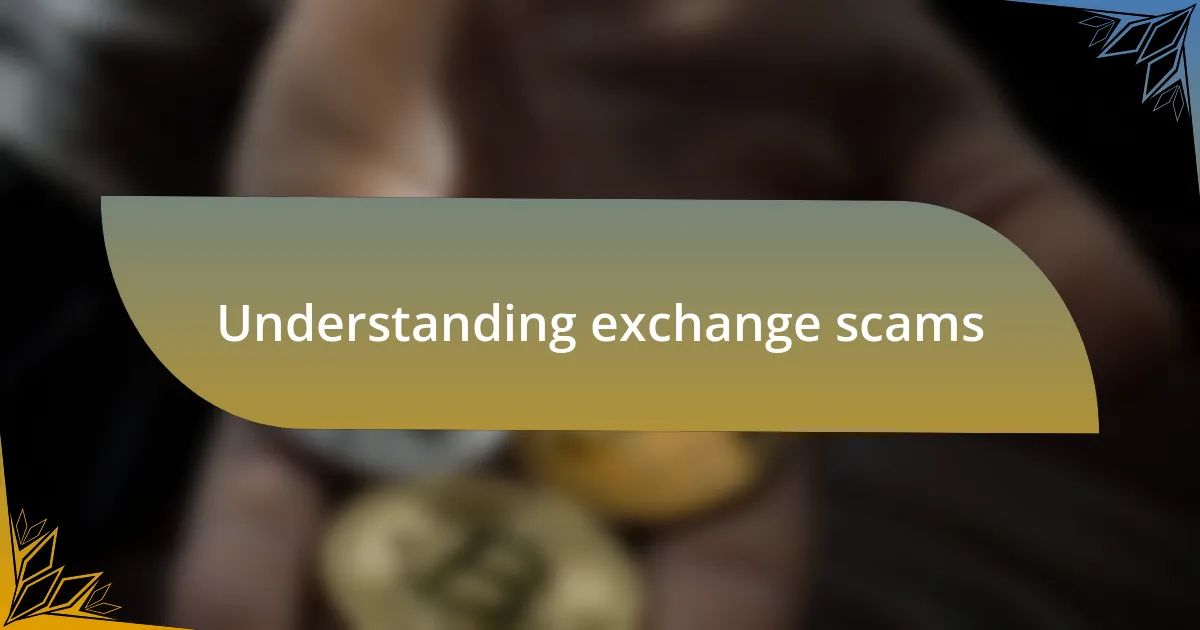
Understanding exchange scams
Exchange scams can take many forms, and they often prey on newcomers in the cryptocurrency space. I remember my first encounter with a platform that promised unrealistically high returns. It seemed too good to be true, and in hindsight, it was. Have you ever felt that nagging doubt after making a hasty decision? It’s a common feeling, often for a good reason.
Many scams involve fake exchanges that appear legitimate at first glance. I once came across a clone of a popular site, with a near-identical interface. It was easy to get lured into thinking it was safe. This experience taught me the importance of double-checking URLs and looking for secure connections. How often do we blindly trust what we see online without a second thought?
Another tactic scams use is aggressive marketing, utilizing social media and influencers to create the illusion of credibility. I’ve seen friends fall victim to this kind of manipulation, convinced by flashy ads and celebrity endorsements. It raises an important question: Are we evaluating the evidence carefully, or are we just swept up in the excitement? Recognizing these red flags is essential to protecting yourself in the volatile world of cryptocurrency trading.
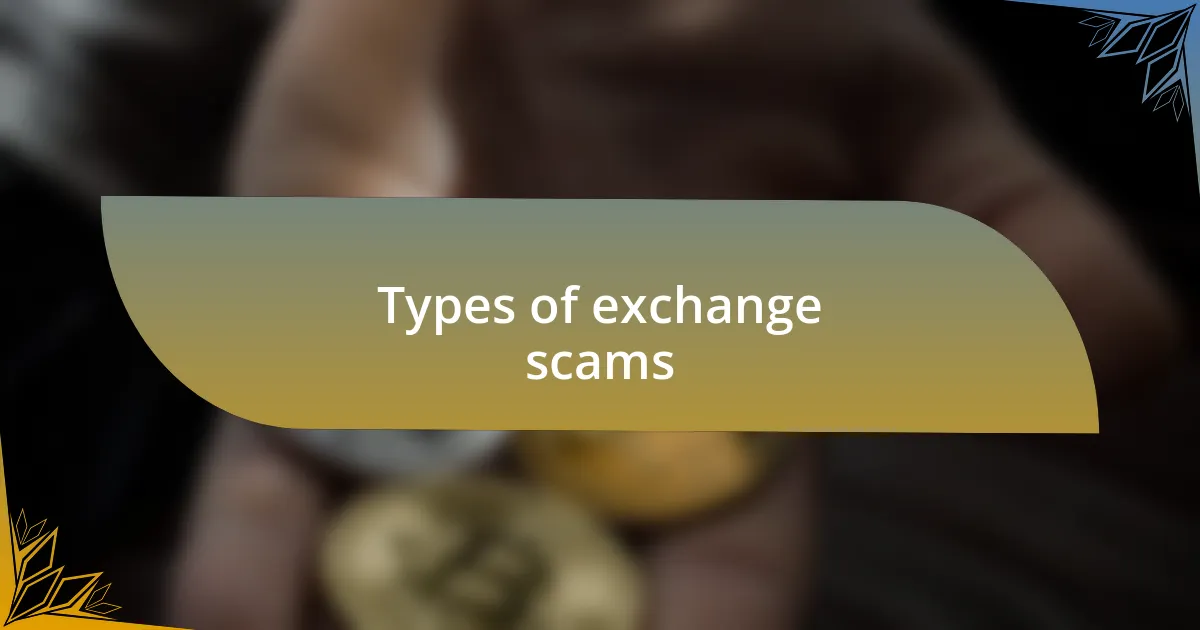
Types of exchange scams
When it comes to exchange scams, one of the most common types is the phishing scam. I recall receiving an email that looked just like it came from a well-known exchange, urging me to verify my account details. For a moment, I hesitated, feeling that familiar twinge of anxiety. Thankfully, a quick glance at the sender’s address revealed it was a fraudulent attempt. It’s astonishing how convincing some of these scams can be, right?
Another prevalent scam involves Ponzi schemes disguised as trading platforms. In my early days, I stumbled upon a group that promised tenfold returns on my investments if I referred others. The excitement was palpable, but my instincts kicked in, warning me of the unsustainability of such promises. How often do we let our hopes cloud our judgment? Recognizing the danger before committing any funds is crucial.
Lastly, there are fake wallet scams, where users are lured into downloading counterfeit wallet applications. I remember a friend who almost fell for one that claimed to provide enhanced security features. It turned out to be a complete hoax, draining his funds before he realized what had happened. This made me wonder: how critical is it to research and verify every tool we use in the crypto space? Each experience reinforces the importance of vigilance in our digital interactions.
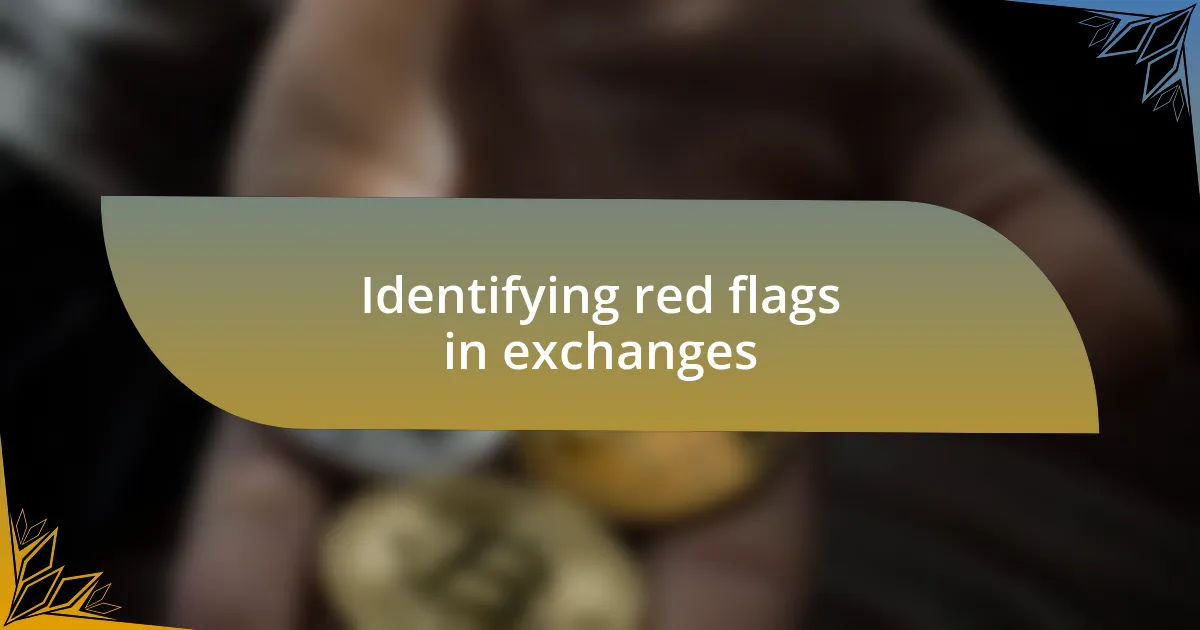
Identifying red flags in exchanges
When I first started exploring cryptocurrency exchanges, I quickly learned to watch for suspicious website designs. Some platforms appeared hastily constructed, with broken links or poor-quality graphics, which raised immediate red flags for me. It made me wonder, how can a platform that’s handling my hard-earned money be so carelessly presented?
Additionally, I’ve noticed that exchanges lacking transparency in their operations often raise my eyebrows. For example, I once encountered an exchange that wouldn’t disclose its physical address or team information. It felt like stepping into a dark room without a flashlight—just an unsettling feeling that something wasn’t quite right. Does it not make you cautious too, when you can’t find easily accessible information about those who are managing your investments?
Perhaps the most alarming indicator I’ve seen is when an exchange offers incredibly high returns with no clear explanation. I remember being drawn into an enticing offer that promised returns that seemed too good to be true. It quickly dawned on me that legitimate investments rarely boast such unrealistic projections. In hindsight, it’s a valuable reminder that if something sounds too good to be true, it probably is.
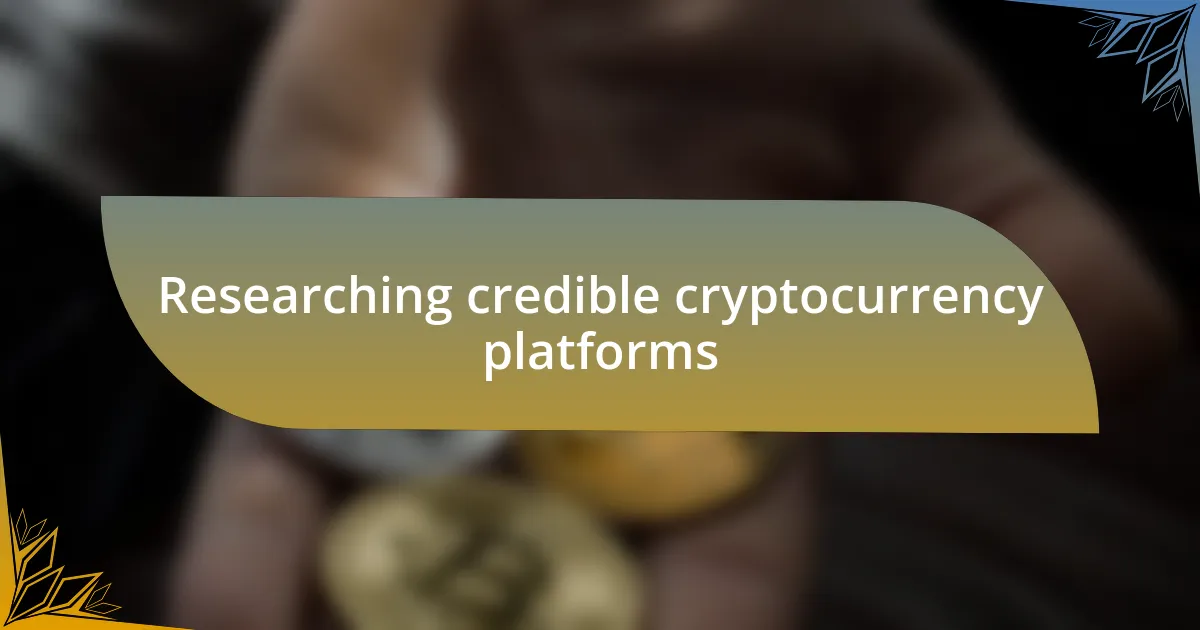
Researching credible cryptocurrency platforms
When I’m researching credible cryptocurrency platforms, the first step I take is to check their regulatory status. There’s something reassuring about knowing that an exchange adheres to guidelines set by authorities. I recall a time when I discovered a platform that claimed to be regulated, but a quick search revealed it was operating in a jurisdiction with minimal oversight. It made me realize how vital it is to verify claims instead of taking them at face value.
I also dig into user reviews and feedback. There was an instance when I came across a highly recommended platform, but as I delved deeper, I found a slew of negative experiences shared by users. Their stories of frustrating withdrawals and unclear customer service echoed my own fears. This led me to question: how often do we overlook user experiences, focusing solely on the surface reputation?
Lastly, I pay attention to the platform’s history and team behind it. Some exchanges have a longer track record than others, and with that history often comes a reputation—good or bad. When I first considered a less-known exchange, I couldn’t find much information about its founders or their backgrounds. This caused a sense of unease; after all, would you trust a ship captain with no experience navigating the seas? Familiarizing myself with the people who run the platform can significantly influence my decision-making process.
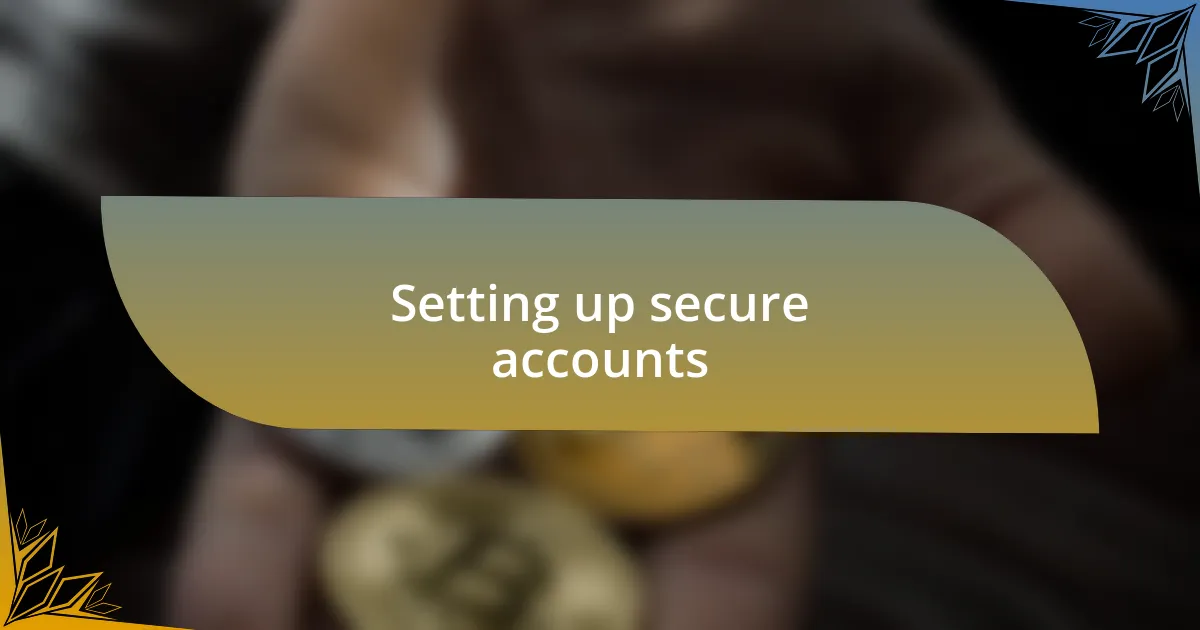
Setting up secure accounts
When I set up secure accounts, the first thing I do is create strong, unique passwords. I’ve learned the hard way that using a simple password can be a major vulnerability. I remember when a friend of mine had their account compromised because they used the same password across multiple sites. Now, I always use a password manager to generate and store complex passwords—it saves time and adds an extra layer of security.
Enabling two-factor authentication (2FA) is another essential step I take. It’s a powerful tool that makes it more challenging for hackers to gain access, even if they have my password. I won’t forget the relief I felt the day I enabled 2FA on my accounts. Suddenly, I felt like I had a strong shield protecting my digital assets. Has it ever occurred to you how much peace of mind this extra step can bring?
Additionally, I always make sure to update my recovery information. It’s easy to overlook, but ensuring my email and phone number are up to date can save me from a lot of stress later. I once lost access to an account for months simply because I hadn’t updated my recovery options. That experience taught me the importance of regularly reviewing these details—something that can make a world of difference in securing my accounts.
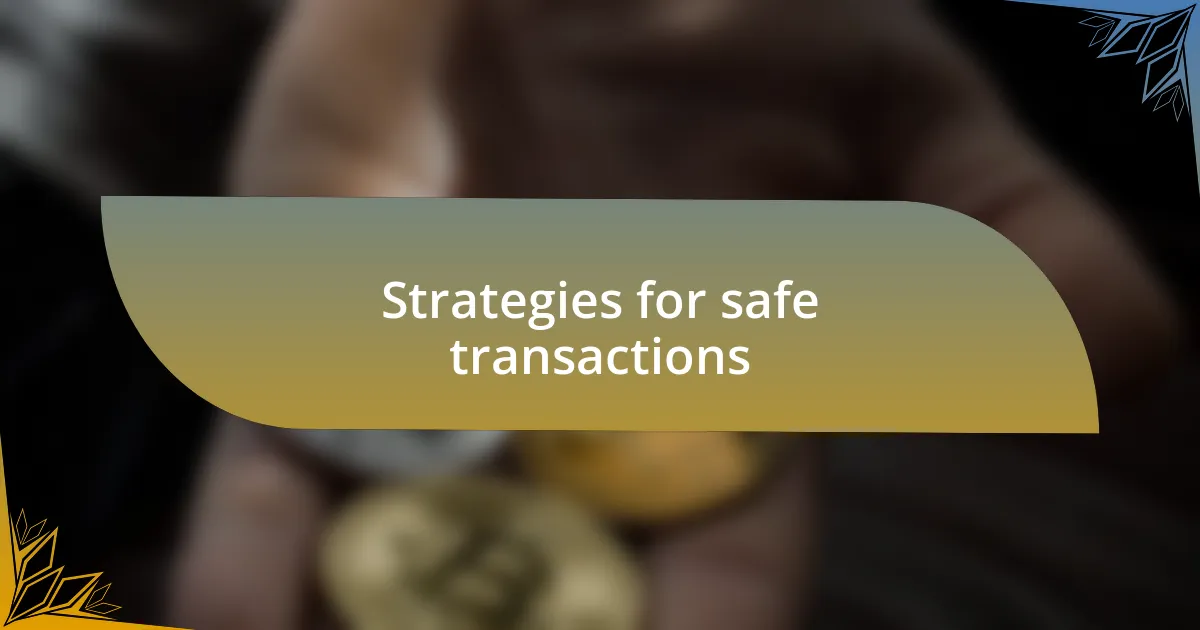
Strategies for safe transactions
When conducting transactions, I always double-check the recipient’s details before hitting that final button. I recall a time when I almost sent a substantial amount to the wrong wallet address just because I skimmed through the information quickly. It made me realize that taking a moment to verify can prevent a potentially devastating mistake. Have you ever wished you could take back a transaction? Taking those extra few seconds each time could save a lot of regret.
Using reputable and secure platforms is another strategy I stand by. I prefer exchanges that have been around for a while and have built a strong reputation. In my early days, I learned the importance of this lesson when I selected a lesser-known platform and faced issues with withdrawal limits. Choosing a well-established exchange might seem basic, but it significantly reduces the risk of scams and fraud.
Finally, I avoid public Wi-Fi networks when making transactions. A couple of years ago, I was at a coffee shop and needed to complete a transfer. I almost did it on their Wi-Fi until I remembered the potential security risks. It’s easy for hackers to intercept data on unsecured networks. Have you ever thought about the vulnerabilities that come with using public internet? Staying away from them keeps my sensitive information safer.
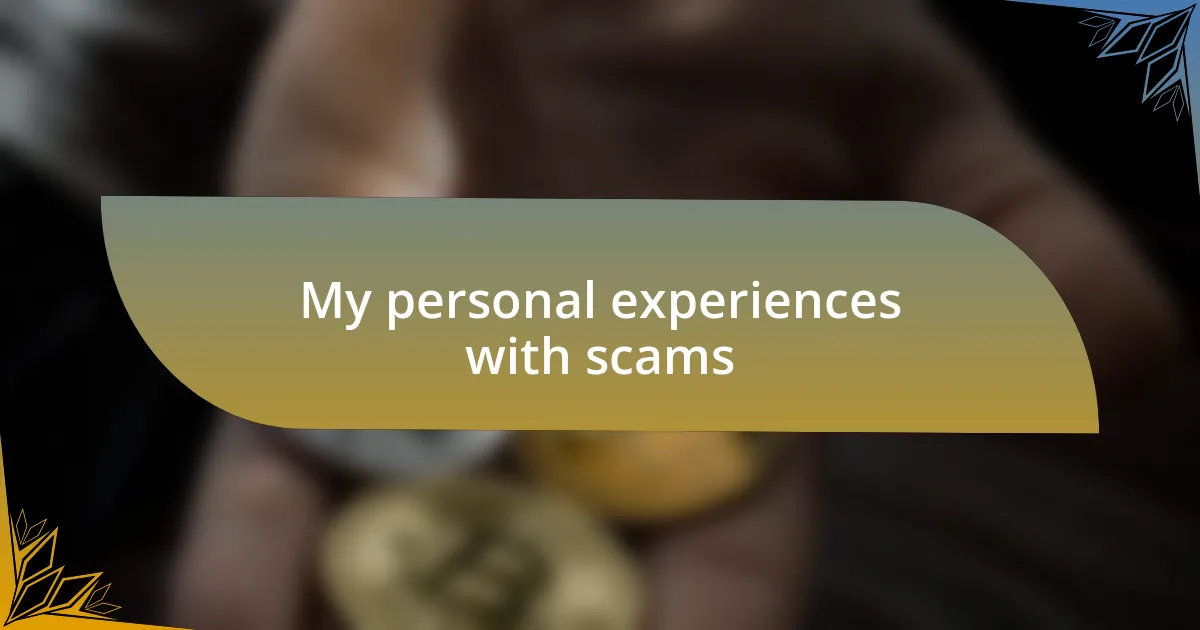
My personal experiences with scams
Reflecting on my past, I recall a time when I was lured into a fake investment opportunity that seemed too good to be true. The promise of guaranteed high returns made my heart race with excitement, but thankfully, my gut instinct held me back. I couldn’t shake the feeling that something was off, and after conducting further research, I discovered the platform had numerous red flags—my intuition saved me from a potential loss.
There was another instance when I ventured into trading on a lesser-known exchange. I was drawn in by some flashy ads and testimonials, only to find my funds locked unexpectedly. It was a stressful few days, filled with frustration as I sought support. I often ask myself, how many people fall for these tricks without realizing the risks? That experience taught me the importance of thorough background checks and sticking to well-known platforms.
Lastly, I remember a friend who was scammed through a phishing email that appeared to be from a legitimate exchange. He felt embarrassed and vulnerable, admitting that he didn’t consider security measures seriously. It made me appreciate how critical it is to stay vigilant and informed. Have you ever felt that exhilarating mix of anxiety and hope in the crypto space? It’s a stark reminder of how swiftly a seemingly innocent action can lead to heartbreak.